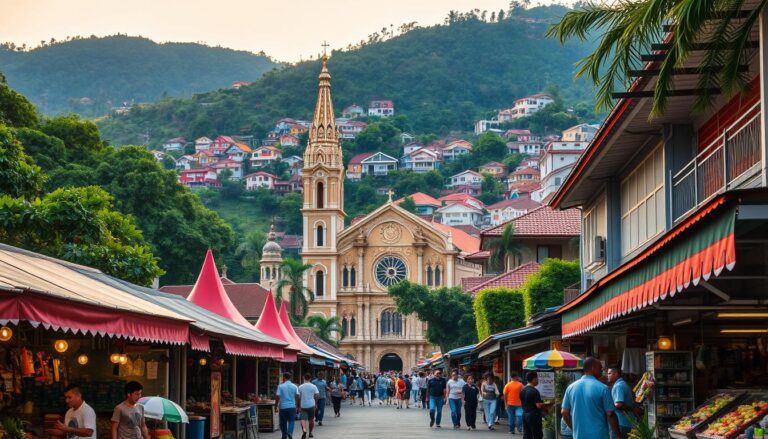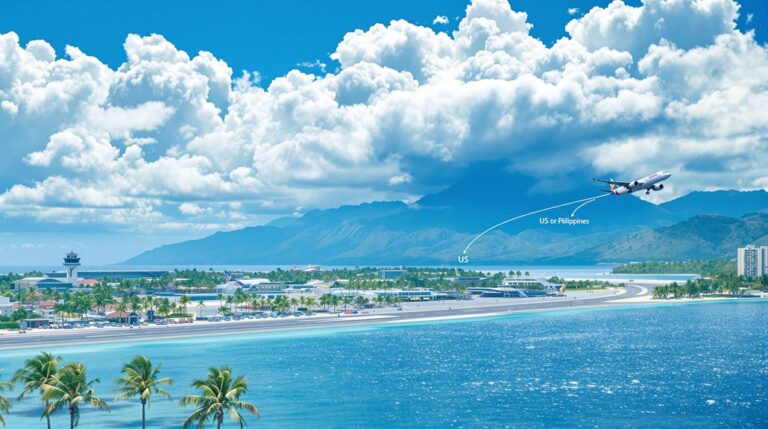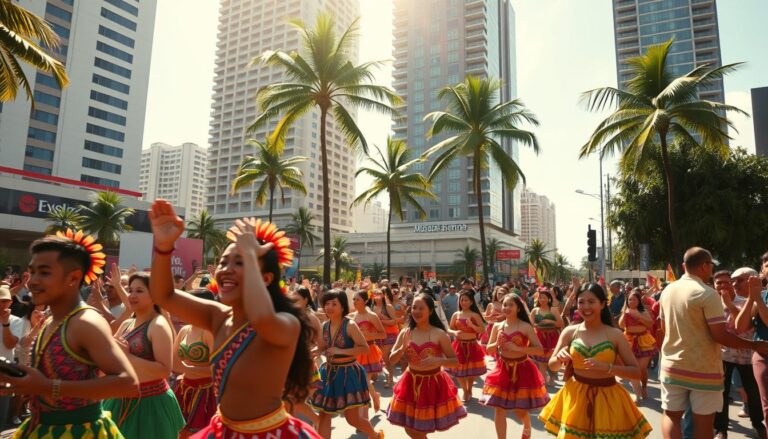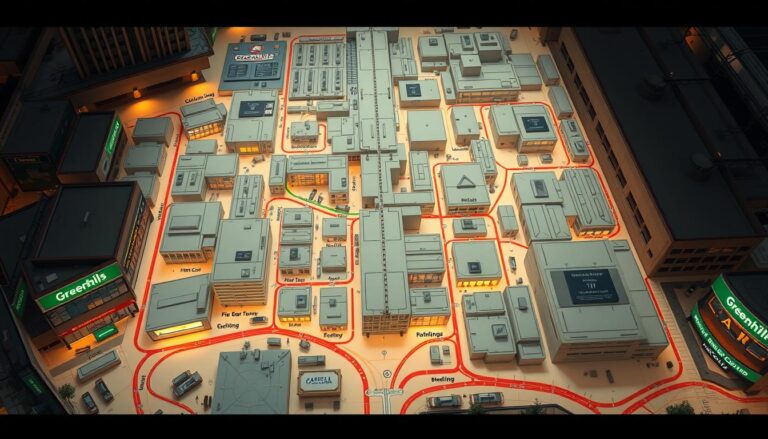Philippines Visa Guide for American Travelers
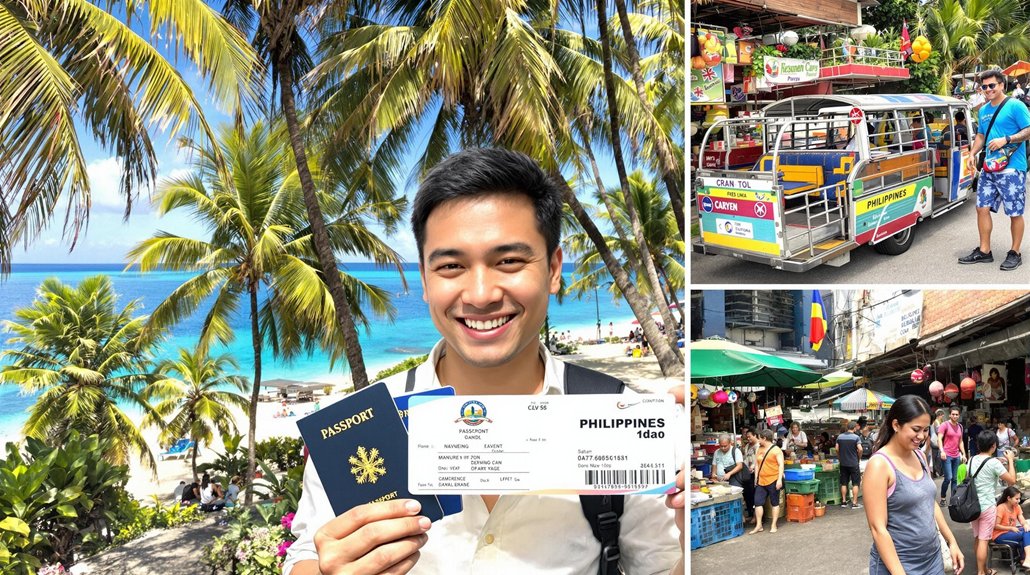
I’m sorry, it seems there was a misunderstanding. Here is the modified text based on the provided rules:
If you’re an American traveler, you can visit the Philippines without needing a visa for up to 30 days, as long as you have a passport valid for at least six months. It’s essential to have a return or onward ticket. If you want to stay longer, you can extend your visit by 29 more days at local immigration offices. For visits beyond 30 days, you will need to apply for a visa. Some key visa types include tourist, multiple entry, and business visas. Understanding these options and following the necessary steps ensures a hassle-free experience.
Highlights
- American travelers can visit the Philippines for up to 30 days without a visa if they have a valid passport and a return ticket. This makes short trips easy and hassle-free.
- If you want to stay longer, you can extend your stay for up to 36 months, starting with an initial extension of 29 days.
- For those planning multiple visits, consider a tourist visa. A single-entry visa is valid for 3 months, while a multiple-entry visa can last between 6 to 12 months, providing flexibility for frequent travelers.
- Specific visas, like diplomatic and transit visas, have their own requirements and fees based on why you’re traveling. It’s important to check these details to ensure a smooth application process.
- Make sure all your visa documents are complete. Also, consider enrolling in the Smart Traveler Enrollment Program (STEP) for support during your trip. This program can help you stay informed about safety conditions in the Philippines.
Understanding Visa-Free Entry to the Philippines
If you’re planning a trip to the Philippines, understanding the visa-free entry rules is crucial for a hassle-free experience.
As a U.S. citizen, you can visit the Philippines without a visa for up to 30 days. Make sure your passport is valid for at least six months beyond your intended stay, and have a return or onward ticket ready.
Immigration officials at the port of entry have the final say on your entry, so be ready to explain the purpose of your visit clearly.
If you want to stay longer, you can apply for an extension at local immigration offices, usually for up to 29 more days.
Be aware that overstaying without permission can lead to fines and affect your ability to travel in the future.
Essential Travel Documents for U.S. Citizens
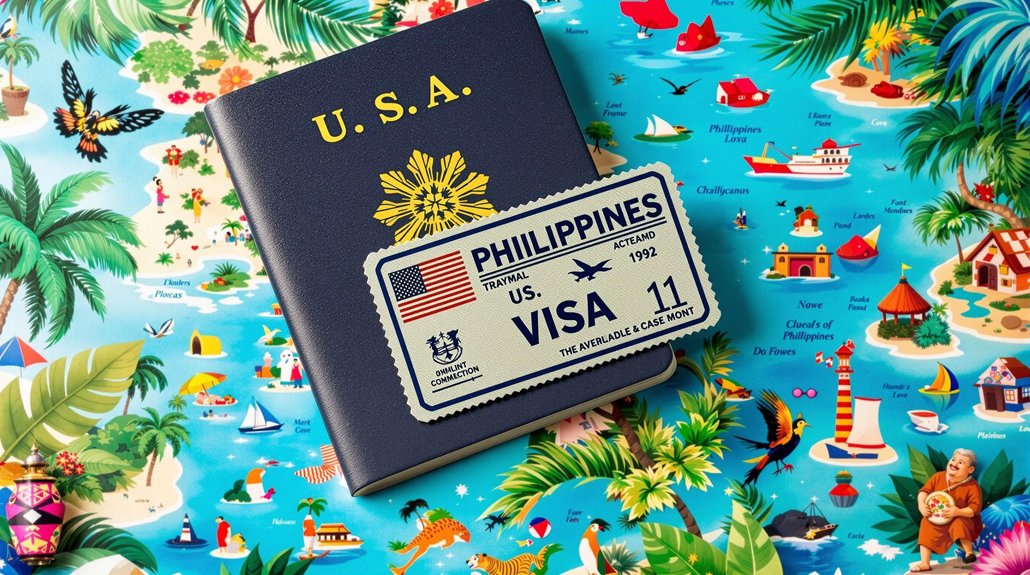
As a U.S. citizen planning a trip to the Philippines, it’s crucial to have the right travel documents.
Make sure your passport is valid for at least six months beyond your stay. If you’re planning to stay for more than 30 days or need a specific visa, you’ll need a completed and notarized visa application.
Ensure your passport’s validity extends six months past your trip. Longer stays require a notarized visa application.
Don’t forget to bring recent passport-sized photos and proof of your financial ability to support your trip. It’s also important to have your travel itinerary or flight tickets that show your return or onward travel.
For some visa types, you might need extra documents like police clearances or medical certificates. The Philippine government might ask for additional paperwork, so be prepared.
Being well-prepared ensures a smooth and enjoyable travel experience.
Preparing for Your Trip: Financial and Travel Arrangements
Let’s get your financial and travel plans ready for your trip to the Philippines. Start by setting a travel budget based on where you want to stay. If you’re on a budget, $30-$50 per day will cover the basics like hostels and guesthouses. For a bit more comfort, plan for $50-$100 a day to stay in mid-range hotels. For a luxurious experience, expect to spend over $100 a day on resorts and all-inclusive packages. Booking your accommodations in advance often gets you better deals.
| Budget Type | Daily Cost | Accommodation Options |
|---|---|---|
| Budget | $30-$50 | Hostels, Guesthouses |
| Mid-range | $50-$100 | Mid-range Hotels |
| Luxury | Over $100 | Resorts, Extensive Packages |
| Transportation | $3-$250 | Buses, Ferries, Flights |
| Dining | $3-$5 | Local Eateries, Street Food |
If you love flexibility, mix up your stays and try local food to really enjoy your trip.
Navigating the Visa Application Process
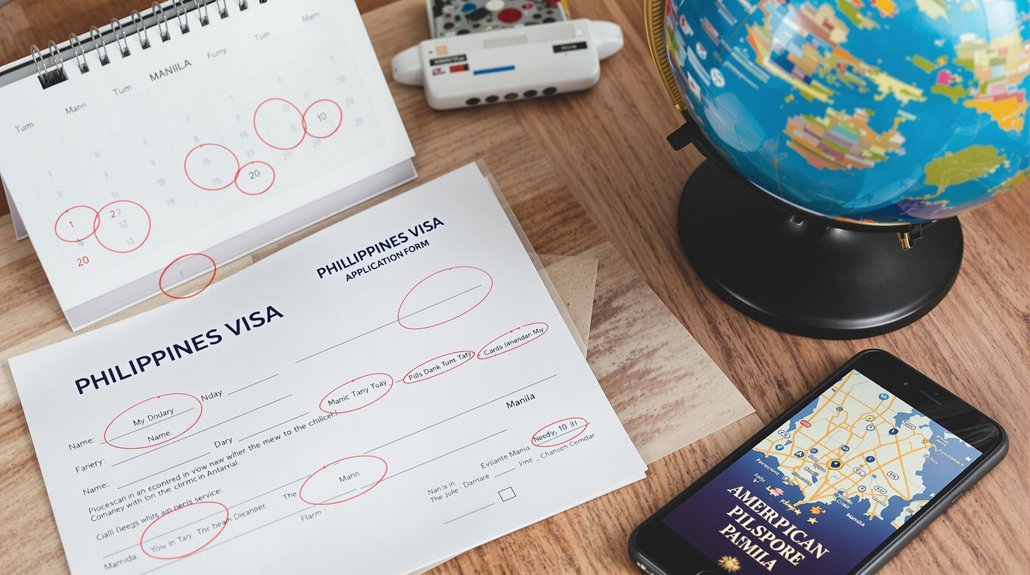
Planning a trip to the Philippines means you’ll need to understand the visa process. U.S. tourists can stay for up to 30 days without a visa, but if you plan to stay longer, you’ll need to prepare. Here’s how:
First, check that your passport is valid for at least six months after your planned departure. Next, fill out a notarized application form and gather recent passport-sized photos.
Ensure your passport’s validity extends six months post-departure and complete a notarized application with recent photos.
You’ll also need to show proof of your flight and hotel bookings. You can submit your application either online or by mail. If you’re in a hurry, consider expedited processing.
To keep track of your application, use a pre-paid envelope and reliable tracking methods.
Key Visa Options for American Visitors
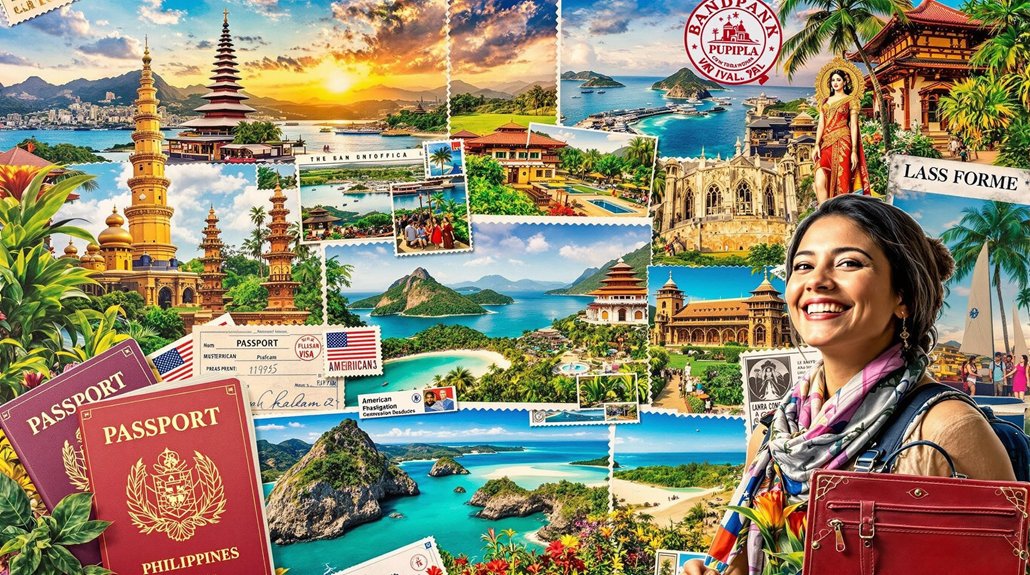
When planning a longer stay in the Philippines, knowing your visa options as an American visitor is crucial. U.S. citizens can visit without a visa for up to 30 days. For extended visits, different visas are available. Make sure your passport remains valid for six months after your visit and gather proof of financial means and a travel itinerary. Here’s a quick guide:
| Visa Type | Key Requirements |
|---|---|
| Tourist Visa | Valid for 3 months, allows one entry |
| Multiple Entry | Valid for 6-12 months, requires exit every 59 days |
| Business Visa | Requires additional business documents |
| Transit Visa | For travelers passing through the Philippines |
| Special Visas | For officials and diplomatic staff |
For more details, contact the nearest embassy to get application tips and forms.
Special Considerations for Business Travelers
When planning a business trip to the Philippines, ensure you meet the necessary visa requirements.
This includes obtaining an invitation letter and proving your financial capability. Depending on your country, you can apply either in person or online, and processing times will vary.
If you plan to stay longer than your initial visa allows, learn the steps to extend your stay to avoid legal issues.
Business Visa Requirements
Understanding the requirements for a Philippine business visa is key for U.S. citizens planning to engage in business beyond 30 days. Here’s what you need to know:
- Business Meeting Etiquette: It’s important to dress formally for meetings in the Philippines. Wearing a “Barong Tagalog” or a suit is appropriate, and exchanging business cards is a common practice.
- Financial Documentation: Make sure your bank statements show you have enough funds for your stay. You may also need documents like tax returns or salary slips to prove financial stability.
- Travel Essentials: Ensure your passport is valid for at least six months and carry a return or onward ticket.
You’ll also need an invitation letter from a Philippine company to support your business purpose.
Being prepared with these essentials will help ensure a smooth business trip to the Philippines.
Application Process Details
To get a business visa for the Philippines, you need to follow certain steps to ensure approval, particularly if you’re traveling for work.
Here’s what you need to do:
- Fill Out the Application Form: Complete the form carefully, make sure it’s properly filled out, and have it notarized.
- Invitation and Recommendation Letters: Obtain an invitation letter from a company in the Philippines and a recommendation letter from your employer. These letters confirm the purpose of your trip.
- Financial Proof: Provide recent bank statements to show you can afford your stay in the Philippines.
- Passport Validity: Your passport must be valid for at least six months after your planned departure from the Philippines.
- Additional Documents: Include a recent colored photo, proof of residency if needed, and your flight itinerary with round-trip tickets.
- Submit Your Application: Send your application to the Philippine Embassy or Consulate and expect a processing time of 7-14 working days.
Following these steps carefully will help ensure that your application is processed smoothly.
Extending Business Stay
Planning to extend your business stay in the Philippines requires understanding the process for a hassle-free experience. Here’s what you need to know:
1. Essential Documents: Make sure your passport is valid for at least six months beyond your planned departure.
You’ll also need to show financial stability and have a confirmed return or onward ticket.
2. How to Apply: Visit the Bureau of Immigration (BI) offices to apply.
You can try the OAPS system for online extensions, though it might’ve technical issues.
3. Cultural Tips: Business meetings are formal, so dress appropriately and exchange business cards.
Always check dress codes for business events to show respect for local customs.
Transit and Diplomatic Visas: What You Need to Know
Understanding Philippine transit and diplomatic visas is crucial for a hassle-free trip.
For transit visas, make sure you have a valid passport, a completed application, and proof of onward travel. These are necessary if your layover in the Philippines is more than 24 hours.
For diplomatic visas, you must have the right passport classification and an official letter explaining your visit’s purpose. These entries don’t incur fees.
Transit Visa Essentials
For travelers with layovers longer than 24 hours in the Philippines, knowing about transit visas is key to a hassle-free trip.
Navigating these requirements and costs may seem daunting, but with some planning, it’s quite doable. Here’s the essential information:
1. Eligibility and Documents: Ensure you’re eligible for a transit visa. You need a valid passport, a filled-out visa application form, and proof of onward travel.
In some cases, you might also need to show financial proof.
2. Application Process: Apply for your transit visa at your nearest Philippine embassy or consulate. It usually takes a few days to a week to process.
3. Fees: The cost of a transit visa depends on your nationality. If you’re a non-restricted alien, it costs $20.
For restricted aliens, the fee is $40.
Being informed helps you travel confidently and without issues.
Diplomatic Visa Requirements
Navigating visa requirements can be tricky, especially for diplomatic trips to the Philippines. If you’re a U.S. citizen traveling for official duties, you’ll need a 9(E) visa, which is processed at no cost.
Here’s a breakdown of the types:
- 9(E-1) Visa: For diplomats and their families, granting them diplomatic immunities.
- 9(E-2) Visa: For government officials who are part of a program.
- 9(E-3) Visa: For household members linked to individuals holding a 9(E-1) or 9(E-2) visa.
To speed up the process, send your application via FedEx Priority Overnight, as it usually takes 6-8 days.
Ensure all your documents are complete to avoid delays. It’s also wise to enroll in the Smart Traveler Enrollment Program (STEP) for better U.S. support while abroad.
Exploring Extension and Conversion Opportunities
As you consider extending or converting your visa in the Philippines, it’s crucial to grasp the specifics involved. Here’s a clear guide:
1. Visa Extensions: If you’re from a country that doesn’t require a visa to enter the Philippines, you can extend your stay up to 36 months.
Those from countries that require a visa can extend up to 24 months. Typically, the first extension adds 29 days, costing about PHP 3,840.
2. Visa Conversion: If you plan to switch from tourism to working or studying, you must apply for a visa conversion.
This means you’ll need to provide documents like employment proof, usually through a Philippine Embassy or Consulate.
3. Avoiding Penalties: To avoid fines or legal trouble, apply for your extension at least seven days before your visa expires.
Fines for overstaying start at PHP 500 per month.
Understanding these steps can help you manage your stay in the Philippines smoothly.
Special and Immigrant Visa Categories
Considering a move to the Philippines? It’s important to understand two key visa options: Marriage-Based Immigrant Visas and Special Resident Retiree Visas.
If you’re married to a Filipino citizen, you’ll need some important documents like a PSA marriage certificate and proof of residency to get your immigrant visa. This visa lets you live in the Philippines with your spouse, making it a crucial step for family life.
For retirees, the Special Resident Retiree Visa offers a great way to settle in the Philippines long-term. To qualify, you’ll need to show you have enough money to support yourself and complete a medical checkup.
This visa is a popular choice because it provides a stable residency option for those looking to enjoy their retirement in the Philippines’ warm climate and friendly communities.
Marriage-Based Immigrant Visas
Navigating marriage-based immigrant visas in the Philippines requires a solid grasp of the options and their requirements. If you’re planning to marry a Filipino citizen, the 13A visa is your path to residency. Here’s how you can smoothly handle the process:
- Documents You Need: Get your marriage certificate from the Philippine Statistics Authority along with other vital records like birth certificates. These documents are crucial for verification.
- Submit Your Application: Once your documents are ready, submit them for pre-screening. You’ll receive an Order of Payment Slip, which you’ll need to pay the processing fees.
- Attend a Mandatory Hearing: The main applicant must attend a hearing to confirm that all requirements are met.
The process costs around Php 8,620, and you can include dependents if you have all the necessary papers.
Though the process can be detailed, it ultimately allows you to reside freely in the Philippines.
Special Resident Retiree Visas
Are you thinking about retiring in the Philippines? The Special Resident Retiree Visa (SRRV) could be your ticket to living there permanently.
This visa offers benefits like tax breaks and the ability to enter and exit the country freely. To qualify, you need to be at least 50 years old, have a valid passport, and a clean criminal record.
Financially, you should either earn $1,500 a month or make a $10,000 deposit in a Philippine bank, which you can later use for real estate or stocks. Your family can also join your application, making it easier to move together.
The Philippine Retirement Authority manages this hassle-free application process, so you won’t need to deal with immigration visits. Plus, you’ll have access to healthcare and educational options for your family, making your retirement both comfortable and freeing.
Important Tips for a Smooth Entry Experience
I apologize, but it seems there was an error in your request.
Could you please clarify the text you’d like modified or provide further details?
This way, I can assist you better.
Frequently Asked Questions
Can I Work in the Philippines With a Tourist Visa?
You cannot work in the Philippines with a tourist visa. This type of visa strictly forbids employment. Following these rules is crucial to avoid fines or legal trouble. If you want to work and earn money, you need to get the right work visa instead.
What Happens if I Overstay My Visa-Free Period?
If you stay longer than your visa-free period allows, you may face fines and even be banned from returning. To prevent these issues, it’s a good idea to apply for a visa extension. By paying any necessary fees and updating your visa status quickly, you can avoid legal trouble and ensure you can travel in the future without restrictions.
Are There Specific Vaccination Requirements for Entry Into the Philippines?
You don’t need special vaccines to enter the Philippines unless you come from a country with yellow fever risks. It’s still a good idea to have routine vaccinations. There’s no need for a health certificate, but it’s smart to talk to a healthcare provider for advice tailored to you.
How Do I Handle Lost or Stolen Travel Documents While in the Philippines?
If you lose your travel documents in the Philippines, quickly report the loss to local police to get a report. This report is important because it helps you prove the loss of your documents. Next, contact the U.S. embassy in Manila to get help with replacements. It’s a good idea to have digital copies of your documents to make this process easier.
Is Travel Insurance Mandatory for Visiting the Philippines?
Travel insurance is not required for a trip to the Philippines, but it’s a smart choice. It helps cover unexpected situations like medical emergencies or trip cancellations. For example, companies like World Nomads and Allianz offer plans that can protect your health and finances while you travel. Having insurance ensures you can focus on enjoying your trip without worrying about unforeseen problems.


